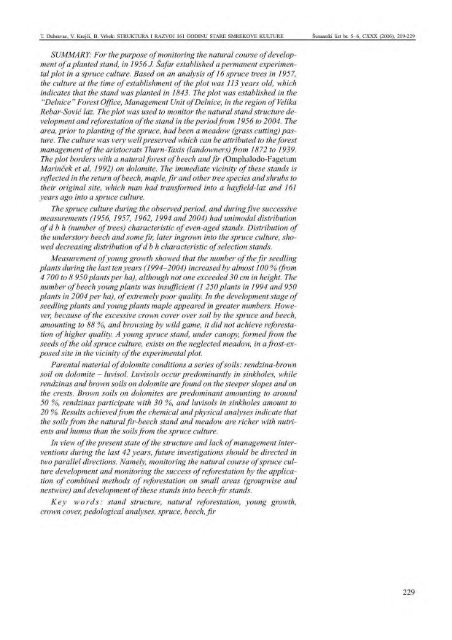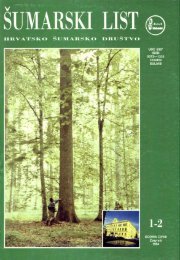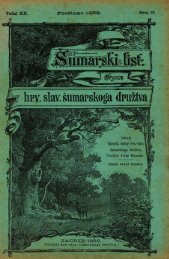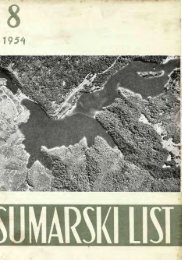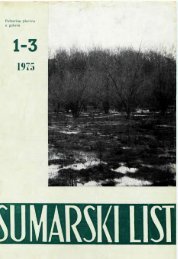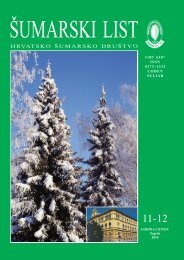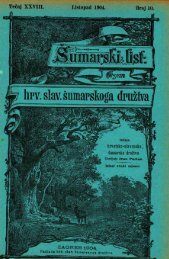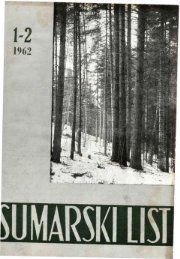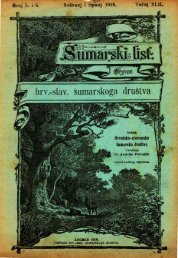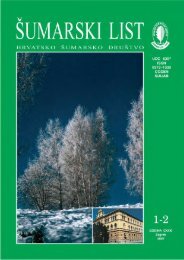T. Dubravac, V. Krejči, B. Vrbek: STRUKTURA I RAZVOJ 161 GODINU STARE SMREKOVE KULTURE Šumarski <strong>list</strong> br. 5–6, CXXX (2006), 219-2294. Brojno stanje pomlatka jele u deset godina povećalo ma s učešćem od 20 %. Raprostranjenje tri glavna tipatla uvjetovano je građom mezo reljefa. Rezultatise skoro 100 % (sa 4700 na 8950 jedinki po ha), aliniti jedna nije svojom visinom prerasla <strong>30</strong>cm. Brojnostanje mladika bukve je nedostatno (1250 jedinki prirodne jelovo-bukove sastojine i livade bogatijakemijskih i fizikalnih analiza upućuju kako su tla iz1994. godine, a 2004. godine 950 jedinki po ha), a hranjivima i humusom od tla iz smrekove kulture.kvaliteta izrazito loša, što uz zastrtost od 88 % ukazujena upitnost zadovoljavajuće prirodne obnove. dološkom obradom na više lokaliteta.Razlike bi trebalo statistički potvrditi detaljnijom pe-5. Zbog kvalitete buduće autohtone sastojine i uvjeta za 7. Buduća istraživanja treba usmjeriti u dva usporednanjen povratak, neophodno je provoditi uzgojne zahvatena malim površinama (grupe ili skupine) kako kove kulture, te praćenjem uspjeha obnove kombinismjera i to praćenjem prirodnog tijeka razvoja smre-u kulturi smreke, tako i u novonastaloj sastojini. ranim metodama na malim površinama (grupe ili6. Kultura smreke uspijeva na seriji tala, čija je matična skupine) koje jedino može pogodovati obnovi smreke,te u konačnici razvoju ovih sastojina u pravcu bu-podloga dolomitna. Najzastupljenije je smeđe tlo nadolomitu s učešćem oko 50 %, zatim rendzina na dolomitus učešćem oko <strong>30</strong> % i lesivirano tlo ukovo-jelovih sastojina.vrtača-LITERATURA – ReferencesCestar, D., V. Hren, Z. Kovačević, J. Martinović,Z. Pelcer, (1978): Tipološke značajkešuma na profilu Štirovača-Lešće. Rad. Šumar.inst. 33, Zagreb.D u b ra va c , T., D. Vule ti ć, (2003): Aktivna ilipasivna zaštita šuma-primjer nacionalni parkRisnjak. 8. Hrvatski biološki kongres s međunarodnimsudjelovanjem, 27 rujna – 2. <strong>list</strong>opada2003., usmeno izlaganje, str. 395–396, Proceedings,Zagreb.D u b r a v a c, T., (2005): Primjena digitalizacije krošanjai metode vizualizacije u izučavanju strukturesastojina. Rad. Šumar. inst. 40 (1): 53–72, Jastrebarsko.Dubravac, T., D. Vuletić, B. Vrbek, (2005): NaturalReforestation and Future of Beech and FirForests in the Risnjak NP, Periodicum BiologorumVol 107, br. 1, 73–79, Zagreb.Diaci, J., (2002): Regeneration dynamics i a Norwayspruce plantation on a silver fir-beech forest sitein the Slovenian Alps. Forest Ecology & Management.161 (1–3): 27–38.Frančisković, S., (1981): Šumarstvo u feudalizmui agrarne reforme, Gorski kotar, str. 483–498,Delnice.Matić, S., 1973: Prirodno pomlađivanje kao faktorstrukture sastojine u šumama jele s rebračom(Blechno-Abietetum Horv.). Šum. <strong>list</strong> 9/10:321–358, Zagreb.M at i ć , S., 1983: Utjecaj ekoloških i strukturnih činilacana prirodno pomlađivanje prebornih šumajele i bukve u Gorskom Kotaru. Glas. šum. pokuse21: 223–400, Zagreb.Martinović, J., (2003): Gospodarenje šumskom tlimau Hrvatskoj. Znanstvena knjiga, Šumarskiinstitut, Jastrebarsko, pp 525, Jastrebarsko.228O rša nić, M., S. Mati ć, I. Ani ć, (2001): Struktura iprirodno pomlađivanje smrekovih sastojina u g.j.Štirovača. Znanost u potrajnom gospodarenju hrvatskimšumama, Šumarski fakultet Sveučilišta uZagrebu, Šumarski institut, Jastrebarsko, “Hrvatskešume” d.o.o., str: 107–116, Zagreb.Oršanić, M., D. Tomljanović, J. Tomljanović,(2005): Gospodarenje šumama na Sjevernom Velebitu.Šume i šumarstvo sjevernoga Velebita.Monografija u povodu 240 godina rada Šumarijei osnivanja Šumarskoga muzeja u Krasnu, 73–98,Senj-Zagreb.S e l e t k o v i ć , Z., Z. K a t u š i n , (1992): Klima Hrvatske.Monografija Šume u Hrvatskoj, 13–18,Zagreb.Šafar, J., (1952): Problem izmjene vrsta u šumama,Šum. <strong>list</strong> 89–100, Zagreb.Š a f ar, J., (1955): Problem nadiranja i širenja bukve uarealu jele. Knjiga “Anali Instituta za eksperimentalnošumarstvo Jugoslavenske akademije”,Vol. I, str. 147–189, Zagreb.Š a f ar, J., (1959): Izvorna kronika podataka o radovimana plohi od 2. 6. 1959. Rukopis.Šafar, J., (1963): Uzgajanje šuma. Udžbenik pp. 598,Zagreb.Š a f ar, J., (1965): Pojava proširivanja bukve na DinaridimaHrvatske. Šum. <strong>list</strong> LXXXIX (5–6):198–217, Zagreb.Vukelić, J., Đ. Rauš, (1998): Šumarska fitocenologijai šumske zajednice u Hrvatskoj. Udžbenikpp. 310, Zagreb.
T. Dubravac, V. Krejči, B. Vrbek: STRUKTURA I RAZVOJ 161 GODINU STARE SMREKOVE KULTURE Šumarski <strong>list</strong> br. 5–6, CXXX (2006), 219-229SUMMARY: For the purpose of monitoring the natural course of developmentof a planted stand, in 1956 J. Šafar established a permanent experimentalplot in a spruce culture. Based on an analysis of 16 spruce trees in 1957,the culture at the time of establishment of the plot was 113 years old, whichindicates that the stand was planted in 1843. The plot was established in the“Delnice” Forest Office, Management Unit of Delnice, in the region of VelikaRebar-Sović laz. The plot was used to monitor the natural stand structure developmentand reforestation of the stand in the period from 1956 to 2004. Thearea, prior to planting of the spruce, had been a meadow (grass cutting) pasture.The culture was very well preserved which can be attributed to the forestmanagement of the aristocrats Thurn-Taxis (landowners) from 1872 to 1939.The plot borders with a natural forest of beech and fir (Omphalodo-FagetumMarinček et al, 1992) on dolomite. The immediate vicinity of these stands isreflected in the return of beech, maple, fir and other tree species and shrubs totheir original site, which man had transformed into a hayfield-laz and 161years ago into a spruce culture.The spruce culture during the observed period, and during five successivemeasurements (1956, 1957, 1962, 1994 and 2004) had unimodal distributionof d b h (number of trees) characteristic of even-aged stands. Distribution ofthe understory beech and some fir, later ingrown into the spruce culture, showeddecreasing distribution of d b h characteristic of selection stands.Measurement of young growth showed that the number of the fir seedlingplants during the last ten years (1994–2004) increased by almost 100 % (from4 700 to 8 950 plants per ha), although not one exceeded <strong>30</strong> cm in height. Thenumber of beech young plants was insufficient (1 250 plants in 1994 and 950plants in 2004 per ha), of extremely poor quality. In the development stage ofseedling plants and young plants maple appeared in greater numbers. However,because of the excessive crown cover over soil by the spruce and beech,amounting to 88 %, and browsing by wild game, it did not achieve reforestationof higher quality. A young spruce stand, under canopy, formed from theseeds of the old spruce culture, exists on the neglected meadow, in a frost-exposedsite in the vicinity of the experimental plot.Parental material of dolomite conditions a series of soils: rendzina-brownsoil on dolomite – luvisol. Luvisols occur predominantly in sinkholes, whilerendzinas and brown soils on dolomite are found on the steeper slopes and onthe crests. Brown soils on dolomites are predominant amounting to around50 %, rendzinas participate with <strong>30</strong> %, and luvisols in sinkholes amount to20 %. Results achieved from the chemical and physical analyses indicate thatthe soils from the natural fir-beech stand and meadow are richer with nutrientsand humus than the soils from the spruce culture.In view of the present state of the structure and lack of management interventionsduring the last 42 years, future investigations should be directed intwo parallel directions. Namely, monitoring the natural course of spruce culturedevelopment and monitoring the success of reforestation by the applicationof combined methods of reforestation on small areas (groupwise andnestwise) and development of these stands into beech-fir stands.K e y w o rd s : stand structure, natural reforestation, young growth,crown cover, pedological analyses, spruce, beech, fir229
- Page 5:
IZVORNI ZNANSTVENI ČLANCIUDK 630*
- Page 9 and 10: Z. Cerovečki: Seslerio sadlerianae
- Page 11: Z. Cerovečki: Seslerio sadlerianae
- Page 14 and 15: M. Bobinac: UČINAK PRORJEDA NA PRI
- Page 16 and 17: M. Bobinac: UČINAK PRORJEDA NA PRI
- Page 18 and 19: M. Bobinac: UČINAK PRORJEDA NA PRI
- Page 20 and 21: M. Bobinac: UČINAK PRORJEDA NA PRI
- Page 22 and 23: INSTRUMENTI I OPREMAU ŠUMARSTVUVis
- Page 24 and 25: M. Schneider-Jacoby: POPLAVNA PODRU
- Page 26 and 27: M. Schneider-Jacoby: POPLAVNA PODRU
- Page 28 and 29: M. Schneider-Jacoby: POPLAVNA PODRU
- Page 30 and 31: M. Schneider-Jacoby: POPLAVNA PODRU
- Page 32 and 33: M. Schneider-Jacoby: POPLAVNA PODRU
- Page 34 and 35: M. Schneider-Jacoby: POPLAVNA PODRU
- Page 36 and 37: M. Schneider-Jacoby: POPLAVNA PODRU
- Page 38 and 39: M. Schneider-Jacoby: POPLAVNA PODRU
- Page 40 and 41: M. Schneider-Jacoby: POPLAVNA PODRU
- Page 42 and 43: M. Schneider-Jacoby: POPLAVNA PODRU
- Page 44 and 45: M. Schneider-Jacoby: POPLAVNA PODRU
- Page 46 and 47: M. Schneider-Jacoby: POPLAVNA PODRU
- Page 48 and 49: OVLAŠTENI ZASTUPNIK PROIZVOĐAČA
- Page 50 and 51: T. Dubravac, V. Krejči, B. Vrbek:
- Page 52 and 53: T. Dubravac, V. Krejči, B. Vrbek:
- Page 54 and 55: T. Dubravac, V. Krejči, B. Vrbek:
- Page 56 and 57: T. Dubravac, V. Krejči, B. Vrbek:
- Page 61 and 62: AKTUALNOObilježavajući izuzetne o
- Page 63 and 64: Šumarska sekcija Hrvatsko-slavonsk
- Page 65 and 66: mio i rukopis za Šumarski priručn
- Page 67 and 68: Zatim se nazočnima obratio državn
- Page 69 and 70: Slavko Matić, Igor Anić, Branko B
- Page 71 and 72: - Znanstvene i stručne aktivnosti
- Page 73 and 74: demiju povodom 160. obljetnice HŠD
- Page 75 and 76: olino okrugli stol i raspravu pod n
- Page 77 and 78: HŠD-a Buzet pobrinuli su se za mal
- Page 79 and 80: Sadržaj skupa bile su erozija i bu
- Page 81 and 82: status šumarskih stručnjaka s koj
- Page 83 and 84: Za serije fotografija žiri se odlu
- Page 85 and 86: uz rijeke i močvare, podalje od mo
- Page 87 and 88: IZAZOVI I SUPROTSTAVLJANJAZAR I ZBO
- Page 89 and 90: EMINOVAČKA ŠUMA - POŽEŠKI MAKSI
- Page 91 and 92: U okruženju šume smješten je doj
- Page 93 and 94: dinamičnije. To su elementi koji s
- Page 95 and 96: Slika 7. Raskošne boje crnjuše u
- Page 97 and 98: Slika 3. Na Zelovu pod Svilajom obi
- Page 99 and 100: ŠUMSKI ŠTETNICIVRBOTOČACLeptira
- Page 101 and 102: ka pisane riječi prenese na papir,
- Page 103 and 104: Dio talijanskog šumarskog svijeta
- Page 106 and 107: Drvni prirastnajvažnija obnovljiva
- Page 108 and 109:
Crkvi (V. Banin, S. Hodorovsky, A.
- Page 110 and 111:
Novoj Gradiški. Poslije rata radio
- Page 112 and 113:
kon. Vodi se kao apsolvent 1923/33.
- Page 114 and 115:
IZ HRVATSKOGA ŠUMARSKOGA DRUŠTVAJ
- Page 116 and 117:
vačka skupština Komore. U tijeku
- Page 118 and 119:
IN MEMORIAMAKADEMIK DUŠAN KLEPAC (
- Page 120 and 121:
U požeškoj je bolnici u četvrtak
- Page 123 and 124:
UPUTE AUTORIMAŠumarski list objavl


